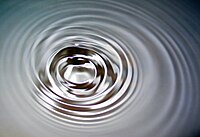
Photo from wikipedia
Detection and monitoring of corrosion and erosion damage in pipe bends are open challenges due to the curvature of the elbow, the complex morphology of these defects, and their unpredictable… Click to show full abstract
Detection and monitoring of corrosion and erosion damage in pipe bends are open challenges due to the curvature of the elbow, the complex morphology of these defects, and their unpredictable location. Combining model-based inversion with guided ultrasonic waves propagating along the elbow and inside its walls offers the possibility of mapping wall-thickness losses over the entire bend and from a few permanently installed transducers under the realm of guided wave tomography (GWT). This paper provides the experimental demonstration of GWT of pipe bends based on a novel curved ray tomography algorithm and an optimal transducer configuration consisting of two ring arrays mounted at the ends of the elbow and a line of transducers fixed to the outer side of the elbow (extrados). Using realistic, localized corrosion defects, it is shown that detection of both the presence and progression of damage can be achieved with 100% sensitivity regardless of damage position around the bend. Importantly, this is possible for defects as shallow as 0.50% of wall thickness (WT) and for maximum depth increments of just 0.25% WT. However, due to the highly irregular profile of corrosion defects, GWT generally underestimates maximum depth relative to the values obtained from 3-D laser scans of the same defects, leading in many cases to errors between 3% WT and 8% WT.
Journal Title: IEEE Transactions on Ultrasonics, Ferroelectrics, and Frequency Control
Year Published: 2017
Link to full text (if available)
Share on Social Media: Sign Up to like & get
recommendations!